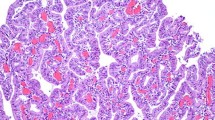Summary
The histochemical staining, labeling index and incorporation of [3H] thymidine [TdR] in large intestinal epithelium were compared in four anatomically distinct segments from ICR/Ha and C57B1/Ha mice. This comparison was done because the incidence of 1,2-dimethylhydrazine (DMH)-induced carcinomas is different for different anatomic segments as well as for the two strains. Within each strain, the amount of [3H] TdR incorporated into mucosal DNA was found to vary less than 20% at each anatomic site of the large intestine. However, there were site-specific differences in the depth of the proliferative populations within the crypts. In autoradiograms from both strains, the crypts of the proximal colon showed maximal [3H] TdR labeling of nuclei in midcrypt cells, some of which contained mucin. In contrast, the distal colon and rectum were characterized by maximal nuclear labeling in a population of undifferentiated cells near the base of each crypt. In distal ICR/ Ha colon, the proportion of labeled nuclei at each crypt depth corresponded to the [3H] TdR labeling of DNA that had been isolated from frozen sections cut sequentially.
As visualized with alcian blue-periodic acid Schiff (AB-PAS) and high iron diamine-alcian blue (HID-AB) stains, the epithelial mucin showed site-specific differences, but the differences between the two strains of mice were not remarkable. In contrast to the human and rat large intestine, the acidic mucin in the mouse large intestine was predominantly sialomucin. However in the cecum and mid-distal colon, there was a predominance of sulfomucin.
In the various anatomic segments of both strains, the histochemical staining, labeling index and incorporation of [3H]TdR were remarkably similar considering the large differences in susceptibility to chemically-induced neoplastic change.
Similar content being viewed by others
Abbreviations
- AB:
-
Alcian blue
- DMH:
-
1,2-dimethylhydrazine
- dpm:
-
disintegrations/min
- HID:
-
high iron diamine
- H&E:
-
hematoxylin and eosin
- PAS:
-
periodic acid Schiff
- TdR:
-
thymidine
- CR:
-
colorectal
References
Barbolt T, Abraham R (1978) The effect of bran on dimethylhydrazine-induced colon carcino-genesis in the rat. Proc Soc Exp Biol Med 157:656–659
Boffa LC, Vidali G, Allfrey VC (1976) Changes in nuclear nonhistone protein composition during normal differentiation and carcinogenesis of intestinal epithelial cells. Exp Cell Res 98:396–410
Burdette W (1971) Identification of antecedents to colorectal cancer. Cancer 28:51–59
Cole W (1969) Carcinoma of the colon. In: Everson R, Cole W (eds) Cancer of the digestive tract. Appleton-Century-Crofts, New York, pp 87–124
Craddock VM (1971) Liver carcinomas induced in rats by single administration of dimethylnitrosamine after partial hepatectomy. J Natl Cancer Inst 47:889–907
Deschner EE (1974) Experimentally induced cancer of the colon. Cancer 34:824–828
Deschner EE, Long FC (1977) Colonic neoplasms in mice produced with six injections of 1,2-dimethylhydrazine. Oncology 34:255–257
Diamond L, Defendi V, Brookes P (1967) The interaction of 7,12-dimethylbenz(a)anthracene with cells sensitive and resistant to toxicity induced by this carcinogen. Cancer Res 27:890–897
Diwan BA, Blackman KE (1980) Differential susceptibility of 3 sublines of C57B1/6 mice to the induction of colorectal tumors by 1,2-dimethylhydrazine. Cancer Lett 9:111–115
Evans JT, Hauschka TS, Mittleman A (1974) Differential susceptibility of four mouse strains to induction of multiple large-bowel neoplasms by 1,2-dimethylhydrazine. J Natl Cancer Inst 52:999–1000
Filipe MI, Branfoot AC (1976) Mucin histochemistry of the colon. Curr Top Pathol 63:143–178
Freeman HJ, Spiller GA, Kim YS (1980) A double-blind study on the effects of differing purified cellulose and pectin fiber diets on 1,2-dimethylhydrazine-induced rat colonic neoplasia. Cancer Res 40:2661–2665
Greaves P, Filipe MI, Branfoot AC (1980) Transitional mucosa and survival in human colorectal cancer. Cancer 46:764–770
Jacobs M, Jansson B, Griffin A (1977) Inhibitory effects of selenium on 1,2-dimethylhydrazine and methylazoxymethanol acetate induction of colon tumors. Cancer Lett 2:133–138
McDowell EM, Trump BF (1976) Histological fixative suitable for diagnostic light and electron microscopy. Arch Pathol Lab Med 100:405–414
Pozharisski K (1975) The significance of nonspecific injury for colon carcinogenesis in rats. Cancer Res 35:3824–3830
Russo J, Russo IH (1980) Influence of differentiation and cell kinetics on the susceptibility of the rat mammary gland to carcinogenesis. Cancer Res 40:2677–2687
Schmidt M, Lipkin M (1974) Separation of proliferative and mature cells in stomach, jejunum and colon of rat. Proc Soc Exp Biol Med 146:836–839
Shamberger R, Willis C (1971) Selenium distribution and human cancer mortality. Clin Lab Sci 2:211–216
Shamsuddin AM, Phelps PC, Trump BF (1982) Human large intestinal epithelium. Light microscopy, histochemistry and ultrastructure. Human Pathol (in press)
Shamsuddin AM, Trump BF (1981) Colon epithelium I. Light microscopic, histochemical and ultrastructural features of normal colon epithelium of Male Fischer 344 rats. J Natl Cancer Inst 66:375–388
Spicer S (1965) Diamine methods for differentiating mucosubstances histochemically. J Histochem Cytochem 13:211–234
Sunter JP, Appleton DR, Rodriguez MSB de, Wright NA, Watson AJ (1979 a) A comparison of cell proliferation at different sites within the large bowel of the mouse. J Anat 129:833–842
Sunter JP, Watson AJ, Wright NA, Appleton DR (1979 b) Cell proliferation at different sites along the length of the rat colon. Virchows Arch [Cell Pathol] 32:75–87
Wilson R, Hutcheson D, Wideman L (1977) Dimethylhydrazine-induced colon tumors in rats fed diets with and without bran. Am J Clin Nutr 30:176–181
Wynder E, Reddy B (1975) Dietary fat and colon cancer. J Natl Cancer Inst 54:7–10
Author information
Authors and Affiliations
Additional information
This is contribution # 1063 from the Cellular Pathobiology Laboratory, Department of Pathology, University of Maryland School of Medicine
Submitted in partial fulfillment of the requirements for a Doctor of Philosophy from the University of Maryland
Rights and permissions
About this article
Cite this article
James, J.T., Shamsuddin, A.M. & Trump, B.F. A comparative study of the normal histochemical and proliferative properties of the large intestine in ICR/Ha and C57B1/Ha mice. Virchows Archiv B Cell Pathol 41, 133–144 (1982). https://doi.org/10.1007/BF02890277
Received:
Accepted:
Published:
Issue Date:
DOI: https://doi.org/10.1007/BF02890277




